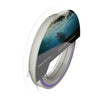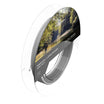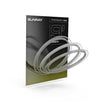In 2012 my good friend Manu Gonetto persuaded me to attend a weekend course on the Italian Style of casting. To be honest I’m not one for courses, casting lessons or casting practice. I know I should be, but I’d rather be fishing. Most of my casting skills have been gleaned by trial & error plus watching experts like Charles Jardine, Andrew Ryan, Roger Beck & others. However I succumbed to Manu’s suggestion & thank God I did because it revolutionised the way I fish, particularly amongst trees & in windy conditions.
Let’s start by looking at the basic principles of the Italian Casting Style as taught by Massimo Magliocco, one of Italy’s top casters. The style evolved to cope with the problems encountered when fishing the dry fly in fast-flowing, heavily wooded streams in which the fish are often deep under overhanging cover & where complex flows generate severe problems of drag.
The ideal tools for the job are a 7’ 6” to 8’, crisp but progressive actioned rod teamed up with a DT 2 or 3 weight line (1 weight lighter than would normally be designated for the rod) (I often use an 8’, 2/3 weight rod with a 1 weight line). Because these casts are high-energy, a long leader (5m/16’) is required (either custom tied or an aggressive profile leader such as a 12’ Rio Powerflex copolymer plus 4’ of tippet). The standard casting stroke is very long & involves tracking the rod tip along a straight line (at least up to the point that the loop is formed). There are no distinct ‘stops’ on the back & forward casts. The Thrust/Tap is more a jab as when thrusting a rapier sword into the target & after both backward thrust & forward thrust there is drift phase to damp any rod tip oscillations & limit energy loss. Furthermore in most of the casts the fly is aimed at the water (rather than a few feet above) so that the fly lands first to delay drag (in most conventional casting the line lands first & drag sets in instantly). This also increases accuracy & ensures that the first thing that the fish senses hitting the water is the fly (potential food) & not the line. Some of the casts, & the long custom tied leaders, in which sections are joined by linked mini-perfection loops, are designed to introduce controlled amounts of slack to delay drag.

Linked Mini-Perfection Loops
Italian Leader Construction: using copolymer (Maxima for all but the tippet)
180cm of 0.50mm, 90cm of 0.40mm, 60cm of 0.30mm, 30cm of 0.20mm, 140cm of 0.14mm tippet
Because of the dynamics of this style very high line speeds & very tight loops are generated & this is why the rod must be under-loaded by 1 or 2 line weights compared with more conventional UK casting.
There is nothing I like better than a bit of challenging fishing. There is little more satisfying than tempting a trout that is rising deep under an apparently impenetrable canopy of low branches or fishing those streams that are so overgrown that you are the only person who fishes there. However to avoid extreme frustration & the possibility of developing turrets syndrome it is vital to have the required skill to effectively cast in these challenging situations.

Massimo Magliocco generating a tight loop
So, let’s deal with those fish deep under low overhanging vegetation, the ones that even a side cast can’t easily reach. Enter the Italian Totally Under the Tip Cast (TUT Cast). The TUT Cast is my most used Italian Style cast. It generates hyper tight horizontal loops just above the water’s surface & high line speed to propel your fly right where you want it. Not only that, but drag is delayed by the fly line landing last (well after the fly has landed). If that isn’t enough, by slowing down the final part of the cast it can be turned into a curve cast to further delay drag. There is however a drawback you’ve got to forget all you learned about conventional casting & learn a totally different casting stroke that breaks all the conventional rules. The casting stroke is made with a horizontal rod & reel in order to generate a horizontal loop just above the water. After the back cast, without stopping the rod is smoothly accelerated forward with the wrist & reel horizontal.
As the hand passes the waist the wrist is smoothly rotated till the reel is vertical & simultaneously the rod tip is accelerated more sharply into the thrust which generates the tight horizontal loop (just above the water), plus the high line speed needed to propel the fly deep under cover. Once the loop has been formed the rod tip is swept upwards during the drift phase of the cast in order to delay the landing of the fly line & ideally give a fly first landing. This cast is also brilliant for punching a fly under the wind when casting into or across the wind. Thanks to this cast I caught my best brown trout of 2015, a fish of 4lb 14oz, from an exposed spot on Driffield Beck, on a day when the wind was gusting at 45mph.

4lb 14oz brownie caught on a day with 45mph gusts
Just to be able to do this one cast makes the task of learning the Italian Style worthwhile, but there are a host of other useful, practical casts that solve many of the problems faced on fast flowing, wooded streams.
The TUT Cast requires room for a back cast, but where this is impossible there is the Cut Cast, very similar to a conventional Snake Roll Cast, that is far more effective than a conventional roll cast, great for the overgrown North Yorkshire Moors streams that I regularly fish.
Other casts include the Superimposed Cast that is designed to propel a hyper-tight loop through small gaps in overhanging trees, the Slowed Down Angular Cast that dumps the whole 16’ leader in a heap when fishing into slack water over a fast current whilst holding the line off the fast water (far more effective that traditional Parachute or Dump Casts), the Overturned Cast that throws the leader & part of the line above the fly to combat drag, plus several others.
Of these other casts the Wave Cast, really a lift, is a superb way to lift the fly & line vertically off the water with minimal disturbance. In situations where you have to cast overland to a fish lying close to your own bank or where you have used a midstream rock that projects above the river surface to anchor your line so that the complex flows below the rock do not generate drag it is possible to lift the line off vegetation or rocks without snagging the fly or blunting the hook point. Thanks to this Cast/Lift I caught one of my best 2015 trout, a fish of 4lb 2oz that was lying in a bankside pocket just above a large thistle. I had no choice but to land my line over the thistle giving me, in theory, just one chance as lifting the line to recast would surely pull my fly into the thistle. The trout in question refused my F Fly first drift but thanks to the Wave Cast/Lift I managed to avoid snagging the thistle & second attempt the fish took. To achieve this the rod tip is lifted smoothly & briskly upwards for about 50cm, whilst the hand is moved forwards. Then the hand is moved rapidly downwards for about 25cm & back up into the back cast.

4lb 2oz brownie caught thanks to the Wave Cast/Lift
I should make a couple of points clear. Firstly, because of the hyper tight loops this style is not suitable for fishing with heavy nymphs. Secondly, although the style is best carried out with a short, relatively stiff rod it can be done with longer, softer rods as long as they are underlined. For fishing with dry flies I often use the Italian Style with my 10’ 4/5 weight rod & a Jeremy Lucas Micro Thin 3 weight line, whilst with my 10’ 2 weight I use either a 1 weight Jeremy Lucas line or for super-delicate presentation a Micro Nymph line. When using these Sunray lines I attach about 7’ of taper from a tapered leader plus about 5’ of tippet even though this is not recommended by Tom & Jeremy. The dynamics of the style allow me to stretch the envelope of delicacy provided by these lines even further than normal.
Should any of my readers be interested in learning this style of casting FFM UK, the UK Italian Casting Team can be contacted via our Facebook page or you can contact us via our website http://www.ffmuk.club/home.html.
There are 2 videos available for purchase & video clips from these are available on You Tube. Massimo Magliocco’s book on the subject, ‘Dry fly fishing in fast water’ (complete with DVD showing the casts) is available from Coch-y-Bonddu Books http://www.anglebooks.com
































